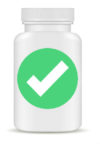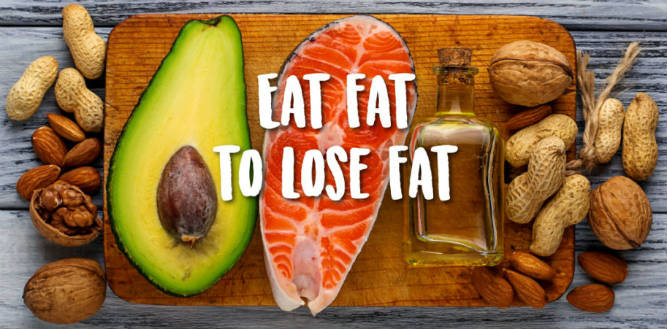Table of Contents
Not All Fat Is Bad – Here is Why High Fat Intake Can Be Beneficial
Essential Fatty Acids (EFAs) – Supplement Profile
Fats serve a broader purpose than simply providing texture, taste and calories to your diet. Just as other nutrients such as vitamins, minerals, and amino acids are essential to life, so are some fats.
Different Types of Fat
Fats come in several forms including in many different lengths and molecular configurations. Stored fat is a mixture of triglycerides. Triglycerides, composed of three fatty acid chains attached to a molecule of glycerol. The most basic distinction made between different types of fatty acids? Saturation.
Saturated Fat
If a fat is saturated, meaning that its fatty acid chains contains many hydrogen molecules attached to them as possible. The negative aspect of any relatively high fat diet comes from the saturated fats. These fats linked to cardiovascular disease. Saturated fat also lowers insulin sensitivity and promotes fat storage and chemically inert in the body. Meaning that it doesn’t participate directly in any chemical reactions as it enters the body. In general saturated fat needs kept to around 10% of total calories.
Unsaturated Fat
If it is unsaturated, it has attachment sites that are empty of hydrogen and at least one double bond between carbon atoms. I don’t feel it is necessary to go further into chemistry as long as you have a basic idea of how to make the distinction between the two forms.
A simple test to tell whether a fat is saturated or not? Look at it at room temperature. If solid like lard, then mostly saturated. If liquid like oil, then mostly unsaturated. Reading the labels on the food you eat is also necessary if you are controlling what type and how much fat you are eating.
Types of Unsaturated Fats
Among the unsaturated fats there are two types. A fatty acid that lacks two hydrogen atoms and has one double bond between carbon atoms is called a monounsaturated fatty acid, because of the single double bond. Oleic acid is an example of a monounsaturated fat.
A fatty acid that lacks four or more hydrogen atoms and contains two or more double bonds between carbon atoms is a polyunsaturated fat. Linoleic acid (two double bonds) and linolenic acid (three double bonds) are examples of polyunsaturated fatty acids.
A fat source that contains mostly these types of fatty acids, considered a polyunsaturated fat. Linoleic acid is a member of the omega-6 family. Linolenic acid is a member of the omega-3 family.
Essential Fatty Acids (EFAs)
The terms omega-6 and omega-3 are probably familiar to you. These fatty acids, called essential fatty acids because our cells do not possess the enzymes necessary to manufacture them.
Essential fatty acids, crucial to many functions in the body. Compounds called eicosanoids, including prostaglandins, and thromboxanes, synthesized from essential fatty acids. Controlling such things as blood pressure, blood clotting, nerve impulses and insulin sensitivity. Also, PPAR activity, hormone responses and a number of other critical functions.
EFAs, great importance to the health conscious bodybuilder. In fact, EFAs, also important to those bodybuilders who could care less about health and only concerned with size and condition.
Most people derive these fatty acids from their diet. Omega-6 fatty acids found mostly in vegetable oils and omega-3s in fish oils.
The problem with most American diets is too much vegetable oil and not enough fish oil. To cover your needs you should get 0.3 percent of calories from linoleic and 0.3 from linolenic acid. This may take some adjustments to the diet and/or the addition of flax and fish oils supplements, but it is a must if you are serious about a finely tuned diet.
Medium Chain Triglycerides (MCTs)
Unique and often misunderstood kind of fat often sold as a weight loss supplement called medium chain triglycerides (MCTs). Saturated fats made into shorter chains. Remember, fats, chains of fatty acids just like carbohydrates, chains of saccharides, and proteins are chains of amino acids. MCTs? Chains of 8 – 10 fatty acids.
Unlike long chain triglycerides, which must first travel through the lymphatic system, MCTs absorbed directly into the portal vein and sent to the liver. MCTs require no bile digested. Making MCTs a crucial energy source for people with digestive maladies.
Under certain circumstances, MCTs, worth taking during a diet. When significantly restricting carbohydrates, MCTs consumed without readily stored as fat. Then converted to ketones and acetone in the liver.
Speeding the transition into ketogenesis. As the body shifts its preference from glucose to ketones, gluconeogenesis slows and muscle is spared. Because MCTs are so readily used for fuel they are also highly thermogenic.
Popular MCT Oils
Coconut oil is a rich source of MCTs. Unfortunately the other saturated fats found in coconut oil are so abundant that it is not a good food choice. If you are going to use MCTs, stick to the purified supplements. Supplementing the diet with MCTs should be done so gradually. Too much at one time can cause gastric distress. Usually a tablespoon with each meal is well tolerated.
MCTs can be mixed with any food you want however they should not be used for cooking or baking. It is important to remember that MCTs do not contain essential fatty acids which our bodies need to survive, therefore other healthy fat sources should be used along with MCTs.
Cholesterol
One fat-like substance that is relevant here is cholesterol. A sterol and is a member of the cyclopentanoperhydrophenanthrene family. Try spelling that one in a Scrabble game! Cholesterol comes only from animal products like meat, eggs and cheese. Cholesterol also produced naturally in the body.
Important to the production of vitamin D3 and serves as a precursor in the testes and adrenal cortex for the production of steroid hormones and cortisol respectively. The molecular backbone of steroid hormones is the same as cholesterol. The body uses cholesterol as building blocks for hormones such as testosterone. Cholesterol also involved in bile production.
Cholesterol incorporated into cell membranes. More than 90% of the body’s cholesterol is found in cell membranes. You seldom hear of the crucial functions that cholesterol plays in the body. Because too much cholesterol can eventually begin to be deposited on the walls of arteries. This is known as atherosclerosis.
While not a book on heart disease we won’t go any further into this issue. Just know that cholesterol is a crucial part of the body and is needed for good health. The risks of moderate to high levels of cholesterol in the diet greatly depend on your genetic vulnerability to heart disease.
Structural Fats
Other fat-like substances such as lecithins and phospholipids are important structurally in the membranes of all cells in the body. Comprising most of the cell membrane, they serve as a container for all the organelles within the cell and also play a very important role in the transport of fat-soluble molecules such as hormones and fat-soluble vitamins. The phospholipids also act as emulsifiers to keep other fats in solution in the blood and body fluids.
Dietary Fat and Hormones
Steroid hormones will be maintained at “normal” levels throughout a fairly wide range of nutritional intake. A few studies have shown that there might be a specific amount of dietary fats that are necessary for optimum testosterone production.
Cortisol and Testosterone
One such study done with hockey players demonstrated that when players had a fat intake at about 41% of calories and then dropped it to just below 30% of calories, there was a significant increase in testosterone, free testosterone and cortisol (Tegelman R, Aberg T, Pousette A, Carlstrom K. Effects of a diet regimen on pituitary and steroid hormones in male ice hockey players. Int J Sports Med. 1992 Jul;13(5):424-30).
Suggested that the elevation in cortisol could be partly explained by the relative negative energy balance maintained by the 30% dietary fat group. Luteinizing hormone was also significantly depressed in the higher fat group.
In another study, when fat intake was reduced from around 100 grams per day to about 20 grams per day, free testosterone dropped significantly (Reed MJ, Cheng RW, Simmonds M, Richmond W, James VH. Dietary lipids: an additional regulator of plasma levels of sex hormone binding globulin. J Clin Endocrinol Metab. 1987 May;64(5):1083-5).
This drop in free testosterone was due to an increase in steroid hormone binding globulin (SHBG). SHBG is a protein that binds to testosterone in the blood rendering it unavailable to directly affect muscle tissue growth. So the more SHBG you have, the lower your bioavailable levels of testosterone. These are but a few of the studies clearly showing the regulatory role of dietary fats on steroid hormone levels within the body.
Fat is As Important As Protein to Bodybuilders
There is certainly much to be learned about essential fatty acids and their role in governing cellular functions. Up until very recently, the media has campaigned hard to get people to eliminate virtually all fat from their diets. This practice is not the optimal way to promote health let alone build new muscle. Bodybuilders who refuse to take fat as seriously as protein are selling themselves short. As the newest research on essential fats and their role in human physiology finally reaches the masses, you will see a whole new appreciation of fat.

